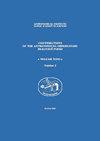利用深度学习分析大气中激光诱导的等离子体羽流
IF 0.2
4区 物理与天体物理
Q4 ASTRONOMY & ASTROPHYSICS
Contributions of the Astronomical Observatory Skalnate Pleso
Pub Date : 2022-12-01
DOI:10.31577/caosp.2022.52.3.126
引用次数: 0
摘要
本文对大气中激光引发放电火花的光谱进行了回归分析。大气等离子体光学发射的光谱图像由条纹相机获得,并在时间上进行积分,以获得不同表观温度下等离子体的样品光谱。我们已经使用主成分分析和分类技术分析了这些光谱。现在,我们通过人工神经网络和深度学习技术进行了深入的研究。也就是说,使用大量测量光谱来训练人工神经网络,以获得表观等离子体温度的估计。对于数据分析的机器学习方法,我们使用Solo+Mia软件包(9.0版,美国Eigenvector Research Inc)。本文章由计算机程序翻译,如有差异,请以英文原文为准。
Analysis of laser induced plasma plume in atmosphere using deep learning
. The regression analysis of spectra of laser initiated electric discharge spark in atmosphere is presented here. Spectral images of optical emission of atmospheric plasma are obtained by a streak camera and integrated in time to obtain sample spectra of plasma with different apparent temperatures. We already have analyzed such spectra using principal component analysis and classification techniques. Now, we have advanced research through the ANN and deep learning technique. Namely, large set of measured spectra are used to train the artificial neural network to obtain the estimation of apparent plasma temperature. For machine learning approach to data analysis we use Solo+Mia software package (Version 9.0, Eigenvector Research Inc, USA).
求助全文
通过发布文献求助,成功后即可免费获取论文全文。
去求助
来源期刊
CiteScore
1.10
自引率
20.00%
发文量
4
审稿时长
>12 weeks
期刊介绍:
Contributions of the Astronomical Observatory Skalnate Pleso" (CAOSP) is published by the Astronomical Institute of the Slovak Academy of Sciences (SAS). The journal publishes new results of astronomical and astrophysical research, preferentially covering the fields of Interplanetary Matter, Stellar Astrophysics and Solar Physics. We publish regular papers, expert comments and review contributions.

 求助内容:
求助内容: 应助结果提醒方式:
应助结果提醒方式:


